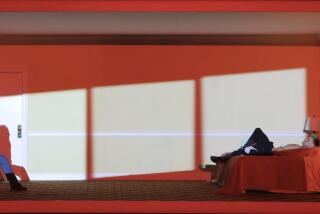Harping on the Past : For Patrick Ball, Billed as the ‘Celtic Bard,’ Folk Tales Are an Essential Backup
- Share via
Listening to the distinctive bell-like sounds of the Celtic harp, it’s difficult to imagine why the instrument fell into disuse about two centuries ago.
There were political reasons: The instrument, which is about 1,000 years old, was a symbol of Gaelic culture, and Ireland was oppressed by the English. There were artistic reasons: People began playing pianos and organs.
But according to Patrick Ball, billed as the Celtic Bard, there was an additional reason: It had become harder for harpers to keep their nails nice.
“In earlier times, poets and bards and harp players were attached to the kings and chieftains,” said Ball, 45, who performs a pair of shows today at San Juan Capistrano Regional Library. “When the English came, the harp players and bards and poets were set out on the roads.
“The Irish harp was, and still is, played with your fingernails. When the patronage system died out in Ireland, harp players had to, God forbid, work for a living when they weren’t playing. That was hard on the fingernails. They switched from brass-strung harps, the traditional Celtic harp, to gut-strung harps, which they could play with the finger pads.”
Four of Ball’s seven recordings (six solo instrumental albums and one soundtrack) are dedicated to the music of Turlough O’Carolan, a blind itinerant harpist of the 18th century. His most recent recording, “Fiona” (Fortuna/Celestial Harmonies), is somewhat of a departure; it includes accompaniment on uilleann pipes, penny whistle and fiddle, and only one O’Carolan tune. He is currently at work on his first album of stories.
Ball devotes half his show to storytelling, and that’s a story in itself.
“I have a master’s degree in Irish history,” said Ball, reached by phone recently at his home in Sebastopol, Calif. “When I was writing my thesis, I decided I had to go to Ireland, to do research and drink beer. That’s when I got attracted to the stories. They had such a strange, oblique slant on history. I began to search out the old storytellers.
“When you go well back into Irish history, you reach a point where nobody’s 100% sure if it’s history or mythology. Historians rely on the old storytellers to flesh out events, to give insight into the old invasions, and how the first people came to Ireland.”
Ball says he was initially interested in exotic stories about fairies and other supernatural matters. But the more he researched, the more extraordinary he found the everyday trials of the people, and the contrast between their poverty-stricken lives and the stories they told. He felt the tales had “a buoyancy about them, a resilient quality that reflects the strength” of the people.
*
What Ball values most of all is “the wordplay, the rhythms, the love the Irish have for words. People never wrote these stories down. A lot of them didn’t know how to read or write. The incredible thing about it was that these people were incredibly eloquent yet completely illiterate.
“I grew up in Northern California, where words were tools--you spoke in order to get something across. In the Irish situation, words were a music of their own. It was fabulous to listen to these people tell stories. It never even mattered what the stories were about.”
* Patrick Ball performs tonight at La Sala, San Juan Capistrano Regional Library, 31495 El Camino Real, San Juan Capistrano. 7 and 9 p.m. $5; children 12 and under, $3. (714) 248-7469.


